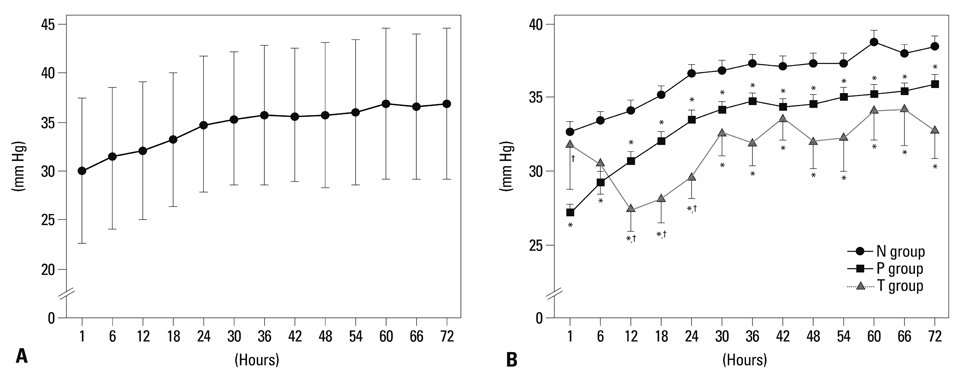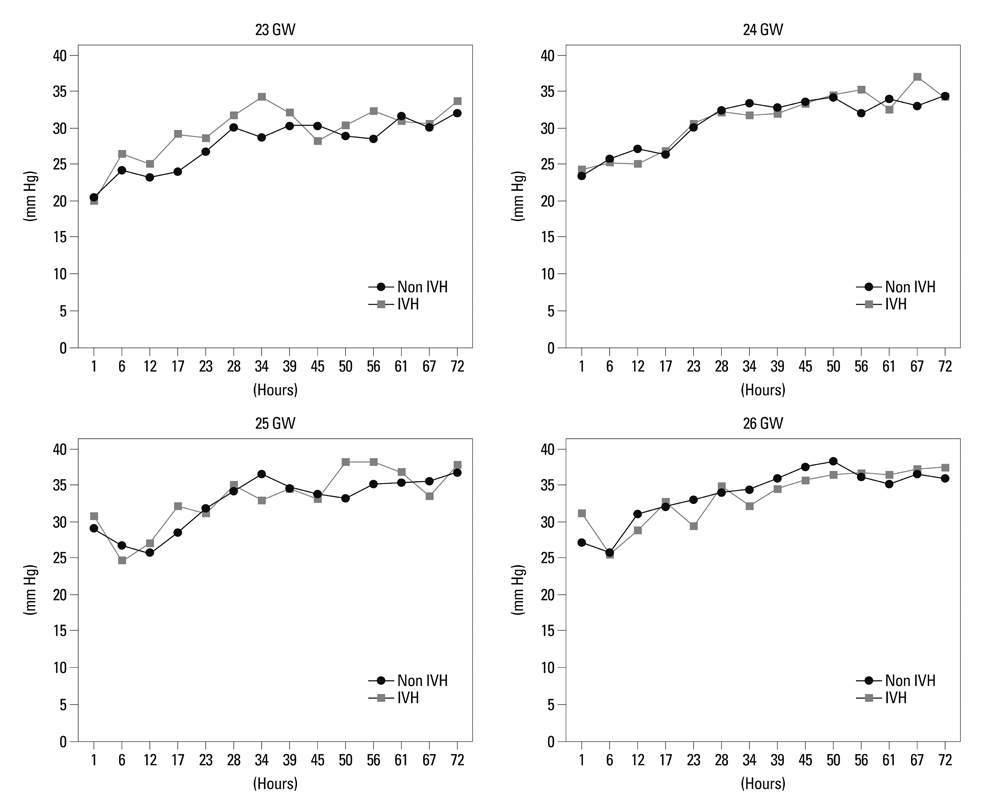Yonsei Med J.
2012 Jul;53(4):765-771. 10.3349/ymj.2012.53.4.765.
Permissive Hypotension in Extremely Low Birth Weight Infants (< or =1000 gm)
- Affiliations
-
- 1Department of Pediatrics, Samsung Medical Center, Sungkyunkwan University School of Medicine, Seoul, Korea. wonspark@skku.edu
- KMID: 1716876
- DOI: http://doi.org/10.3349/ymj.2012.53.4.765
Abstract
- PURPOSE
We performed this study to evaluate the safety of permissive hypotension management in extremely low birth weight infants (ELBWIs).
MATERIALS AND METHODS
Medical records of all inborn ELBWIs admitted to Samsung Medical Center from January 2004 to December 2008 were reviewed retrospectively. Of a total of 261 ELBWIs, 47 (18%) required treatment for hypotension (group T), 110 (42%) remained normotensive (group N), and 104 (40%) experienced more than one episode of hypotension without treatment (group P) during the first 72 hours of life. Treatment of hypotension included inotropic support and/or fluid loading.
RESULTS
Birth weight and Apgar scores were significantly lower in the T group than the other two groups. In the N group, the rate of pathologically confirmed maternal chorioamnionitis was significantly higher than other two groups, and the rate was higher in the P group than the T group. After adjusting for covariate factors, no significant differences in mortality and major morbidities were found between the N and P groups. However, the mortality rate and the incidence of intraventricular hemorrhage (> or =stage 3) and bronchopulmonary dysplasia (> or =moderate) were significantly higher in the T group than the other two groups. Long term neurodevelopmental outcomes were not significantly different between the N and P groups.
CONCLUSION
Close observation of hypotensive ELBWIs who showed good clinical perfusion signs without intervention allowed to avoid unnecessary medications and resulted in good neurological outcomes.
Keyword
MeSH Terms
Figure
Reference
-
1. Barrington KJ, Dempsey EM. Cardiovascular support in the preterm: treatments in search of indications. J Pediatr. 2006. 148:289–291.
Article2. Gill AB, Weindling AM. Randomised controlled trial of plasma protein fraction versus dopamine in hypotensive very low birthweight infants. Arch Dis Child. 1993. 69:284–287.
Article3. Seri I, Evans J. Controversies in the diagnosis and management of hypotension in the newborn infant. Curr Opin Pediatr. 2001. 13:116–123.
Article4. De Zegher F, Van Den Berghe G, Devlieger H, Eggermont E, Veldhuis JD. Dopamine inhibits growth hormone and prolactin secretion in the human newborn. Pediatr Res. 1993. 34:642–645.
Article5. Dempsey EM, Barrington KJ. Treating hypotension in the preterm infant: when and with what: a critical and systematic review. J Perinatol. 2007. 27:469–478.
Article6. Fanaroff JM, Wilson-Costello DE, Newman NS, Montpetite MM, Fanaroff AA. Treated hypotension is associated with neonatal morbidity and hearing loss in extremely low birth weight infants. Pediatrics. 2006. 117:1131–1135.
Article7. Dempsey EM, Al Hazzani F, Barrington KJ. Permissive hypotension in the extremely low birthweight infant with signs of good perfusion. Arch Dis Child Fetal Neonatal Ed. 2009. 94:F241–F244.
Article8. Bada HS, Korones SB, Perry EH, Arheart KL, Ray JD, Pourcyrous M, et al. Mean arterial blood pressure changes in premature infants and those at risk for intraventricular hemorrhage. J Pediatr. 1990. 117:607–614.
Article9. Laughon M, Bose C, Allred E, O'Shea TM, Van Marter LJ, Bednarek F, et al. Factors associated with treatment for hypotension in extremely low gestational age newborns during the first postnatal week. Pediatrics. 2007. 119:273–280.
Article10. Al-Aweel I, Pursley DM, Rubin LP, Shah B, Weisberger S, Richardson DK. Variations in prevalence of hypotension, hypertension, and vasopressor use in NICUs. J Perinatol. 2001. 21:272–278.
Article11. Lubchenco LO, Hansman C, Boyd E. Intrauterine growth in length and head circumference as estimated from live births at gestational ages from 26 to 42 weeks. Pediatrics. 1966. 37:403–408.
Article12. Ehrenkranz RA, Walsh MC, Vohr BR, Jobe AH, Wright LL, Fanaroff AA, et al. Validation of the National Institutes of Health consensus definition of bronchopulmonary dysplasia. Pediatrics. 2005. 116:1353–1360.
Article13. Papile LA, Burstein J, Burstein R, Koffler H. Incidence and evolution of subependymal and intraventricular hemorrhage: a study of infants with birth weights less than 1,500 gm. J Pediatr. 1978. 92:529–534.
Article14. Bell MJ, Ternberg JL, Feigin RD, Keating JP, Marshall R, Barton L, et al. Neonatal necrotizing enterocolitis. Therapeutic decisions based upon clinical staging. Ann Surg. 1978. 187:1–7.15. The Committee for the Classification of Retinopathy of Prematurity. An international classification of retinopathy of prematurity. Arch Ophthalmol. 1984. 102:1130–1134.16. Stoll BJ, Hansen NI, Adams-Chapman I, Fanaroff AA, Hintz SR, Vohr B, et al. Neurodevelopmental and growth impairment among extremely low-birth-weight infants with neonatal infection. JAMA. 2004. 292:2357–2365.
Article17. Leonard CH, Piecuch RE, Cooper BA. Use of the Bayley Infant Neurodevelopmental Screener with low birth weight infants. J Pediatr Psychol. 2001. 26:33–40.
Article18. Pellicer A, Valverde E, Elorza MD, Madero R, Gayá F, Quero J, et al. Cardiovascular support for low birth weight infants and cerebral hemodynamics: a randomized, blinded, clinical trial. Pediatrics. 2005. 115:1501–1512.
Article19. Munro MJ, Walker AM, Barfield CP. Hypotensive extremely low birth weight infants have reduced cerebral blood flow. Pediatrics. 2004. 114:1591–1596.
Article20. Pellicer A, Bravo MC, Madero R, Salas S, Quero J, Cabañas F. Early systemic hypotension and vasopressor support in low birth weight infants: impact on neurodevelopment. Pediatrics. 2009. 123:1369–1376.
Article21. Fanaroff AA, Fanaroff JM. Short- and long-term consequences of hypotension in ELBW infants. Semin Perinatol. 2006. 30:151–155.
Article22. Synnes AR, Chien LY, Peliowski A, Baboolal R, Lee SK;. Variations in intraventricular hemorrhage incidence rates among Canadian neonatal intensive care units. J Pediatr. 2001. 138:525–531.
Article
- Full Text Links
- Actions
-
Cited
- CITED
-
- Close
- Share
- Similar articles
-
- Incidence and Risk Factors of Retinopathy of Prematurity in Extremely Low Birth Weight and Very Low Birth Weight Infants
- Optimal Ventilatory Strategies in Preterm Infants: Permissive Hypercapnia
- Permissive Hyperglycemia in Extremely Low Birth Weight Infants
- Frequency and Etiologies of Hypotension in Extremely Low Birth Weight Infants
- Meconium Obstruction Syndrome in Two Extremely Low Birth Weight Infants



